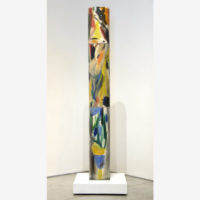ELAINE DE KOONING (1918-1989)
_27843.jpg)
_27843_detail1.jpg)
_27843_detail2.jpg)
_27843_detail3.jpg)
_27843_detail4.jpg)
_27843_detail5.jpg)
_27843_detail6.jpg)
_27843_detail7.jpg)
_27843_detail8.jpg)
_27843_detail9.jpg)
Procedencia
Familia de Elaine de KooningExposición
West Palm Beach, Florida, Ann Norton Sculpture Gardens, Descubrir la creatividad: American Art Masters, del 10 de enero al 17 de marzo de 2024Historia
El brillante relato de Mary Gabriel sobre las mujeres que se pusieron detrás y luego se pintaron de pies a cabeza con sus homólogos masculinos tenía que terminar la historia en algún momento. Después de todo, Ninth Street Women tiene 700 páginas. Pero su capítulo final, apropiadamente titulado "Epílogo", resume la siguiente fase de la Escuela de Nueva York y el Expresionismo Abstracto como si hubiera muerto en 1960, cuando los lienzos rigurosamente pintados por Frank Stella con pintura negra para casas pusieron al mundo del arte de cabeza. En verdad, había algo más que un cambio estacional en el aire de Manhattan, pero para tres mujeres -Joan Mitchell, Helen Frankenthaler y Elaine de Kooning- nada podía estar más lejos de la realidad. Gran parte de sus mejores obras llegarían en las décadas siguientes. En cuanto a Elaine, en 1957 había ganado una dura batalla para lograr la autosuficiencia. Se había liberado de Willem, tenía su propio coche y, como para subrayar ese hecho consumado, viajó al oeste, experimentó el color y la extensión del paisaje y probó el drama y el color de la corrida en la Plaza Monumental de Ciudad Juárez, México. Sus pinturas y dibujos se inspiraron en la docena de corridas a las que asistió. Son transmutaciones de esa experiencia; derviches de color y acción que se agitan. El fervor con el que atacaba el lienzo o el soporte de papel cambió para siempre. De repente, estaba ante un artista que estaba a la altura del ideal de Harold Rosenberg cuando llamó al nacimiento de la "pintura de acción... una arena en la que actuar" y afirmó que lo que aparecía en el lienzo "no era un cuadro sino un acontecimiento".
MásCONOCIMIENTOS DEL MERCADO
- Los dos precios más altos de los cuadros de Elaine de Kooning vendidos en subasta se acaban de fijar en marzo de 2021, lo que indica el valor creciente de las obras de Elaine
- "Bisonte rojo/Caballo azul", de la década de 1980, estableció un nuevo récord para el artista en la subasta del 9 de marzo de 2021, vendiéndose por 562.500 dólares.
- Una semana más tarde, un cuadro de la corrida de Elaine de Kooning de finales de los años 50 se vendió por 428.400 dólares, el segundo precio más alto en una subasta del artista.
- Estamos viendo cómo obras de artistas históricamente infravalorados, como Elaine de Kooning, siguen aumentando su valor.





























